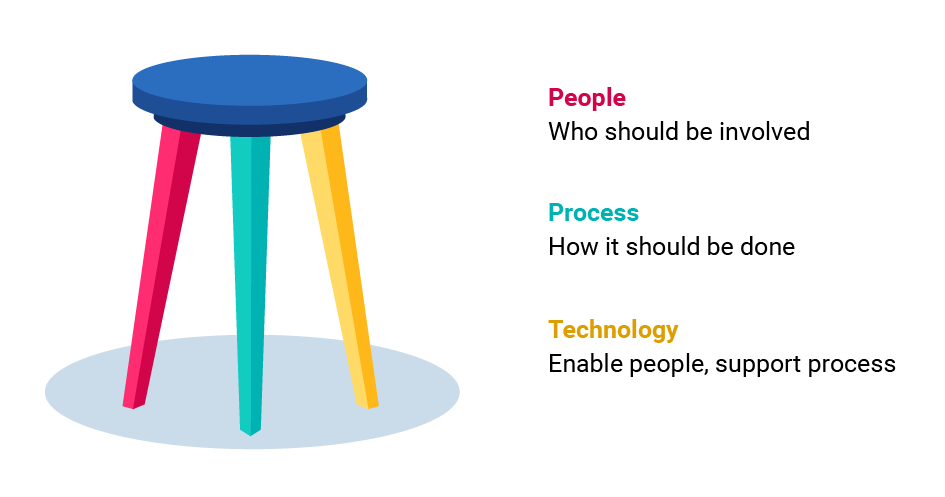In my career working in contact center consulting, and in the area of workforce management in particular, the advances in technology have been significant. In retrospect, we now have software capability beyond what I imagined along the way. However, some constants in the successful implementation of WFM technology have remained. Specifically, understanding the importance of process and the role of human behavior in the adoption and implementation of technology are still among the most critical elements in realizing the "optimization promise" of today's WFM software.
Giving attention to the classic People, Process and Technology framework is still the best formula for realizing the desired ROI in the use of whatever WFM solution is in place.
It has been my observation that there is no shortage of attention given to the Technology leg of this three-legged stool, but not much focus on the other legs of the framework. Software capability will always advance but unless we also advance the Process and People, our results will be sub-optimal. The purpose of this two-part blog series will be to focus on Process which is arguably so intertwined with the People component that we must discuss both.

A continuous improvement model: the why and the what
The Chinese philosopher Lao Tzu said, “The journey of a thousand miles begins with one step.” He wasn’t a contact center WFM leader, but if he was, in my view he certainly wasn't wrong. Let’s take a quick look at The Why and The What of a Continuous Improvement process in contact center WFM in this first installment of the blog and in the second part we will focus on The How. Here we go!
The why
To begin, I must confess I have a belief that our starting point expectations regarding WFM implementations are often too grandiose. We may have unrealistic ideas regarding how “automatic” WFM software really is or how quickly the necessary process changes will be adopted. My admitted bias and commitment with my clients is to the development and execution of a continuous improvement (CI) model and process "plan" as the path to greater long-term and sustainable results.
Having been involved in multiple technology implementations, especially WFM solutions, it’s become evident to me that many organizations miss the opportunity to adequately address and update their contact center and WFM processes through a continuous improvement (CI) methodology. Whether it be from lack of an established CI program, time constraints or just ambivalence, many have missed a critical component of contact center success.
💡 Organizations who embrace a CI methodology see improved productivity, positive customer experience and effective employee engagement.
The what
Continuous improvement describes a long-term strategy focused on improving processes, increasing quality, and cutting waste. Since many of the changes are relatively small, there is usually less resistance and adoption is easier.
To realize desired efficiencies, a business should apply a continuous improvement mindset. Essential to this mindset is removing the “distance” that often occurs between strategic stakeholders and the WFM operations team. It’s all too common that WFM becomes an isolated practice within the organization and only gets attention when the customer experience suffers due to poor performance. We have seen large and small organizations where the business leaders are relatively clueless as to what WFM is and the overall importance it has to the business.
It is imperative that the WFM operations team bridge this distance and become a strategic partner with not only the contact center operations team, but also other groups such as Marketing, Finance, Customer Experience and HR. This may pull some WFMers out of their technology and data comfort zone and requires them to understand the “story” that the data tells in order to discuss options for remediation or continuation.
I often refer to the new WFM function as “Risk Management,” where we analyze and use data to show the potential risks to the operations and customer experience. This understanding of the data fosters productive discussions around operational options that can mediate those risks.
This process of analyzing risk and telling the “story” to contact center operations and leaders lends itself to addressing processes that may be creating risk and thereby cultivating the atmosphere for continuous improvement. Once we’ve established this partnership, it’s much easier for others to see the need for a continuous improvement mindset and process. Attributes of a CI mindset and process are:
- Work is broken into small batches
- Improvement is not necessarily slow but it is often gradual
- There is clarity and measurement on incremental progress
- Key stakeholders and business leaders are involved
- The team is in encouraged to call attention to big and small problems
- The team regularly reviews its progress
- Overall business performance improves
These attributes are inherent to the CI process and should be communicated and understood by all involved. Understanding the value and benefits of each of these is critical to achieving successful outcomes. Once understood, the thought process shifts from, “Things are going wrong,” to “Where is the gap in this process and what would make it better, more efficient or add value?”
As this mindset is embraced and implemented, the WFM team and their internal customers work in concert to look not only at processes related to the WFM function, but also expand their thinking to contact center processes that impact, or are impacted by, WFM and the technology that supports it.
In summary, we’ve explored The Why and The What of continuous improvement. While recognizing the need for a WFM solution is admirable, it may not be the cure-all that you had hoped for if not partnered with a robust continuous improvement program.
- Setting the stage, and educating and communicating the need is essential for acceptance and understanding of the process.
- Establishing recurring team reviews and creating incremental measurements to validate and assess improvement will prevent the team from falling down rabbit holes and chasing false success.
In Part 2, we’ll dive into The How and lay out some clear steps on what the team should do in order to realize success. Stay with us as we continue this journey.
Did you find the article interesting and would like to share it with your colleagues? Download the article as a PDF.





